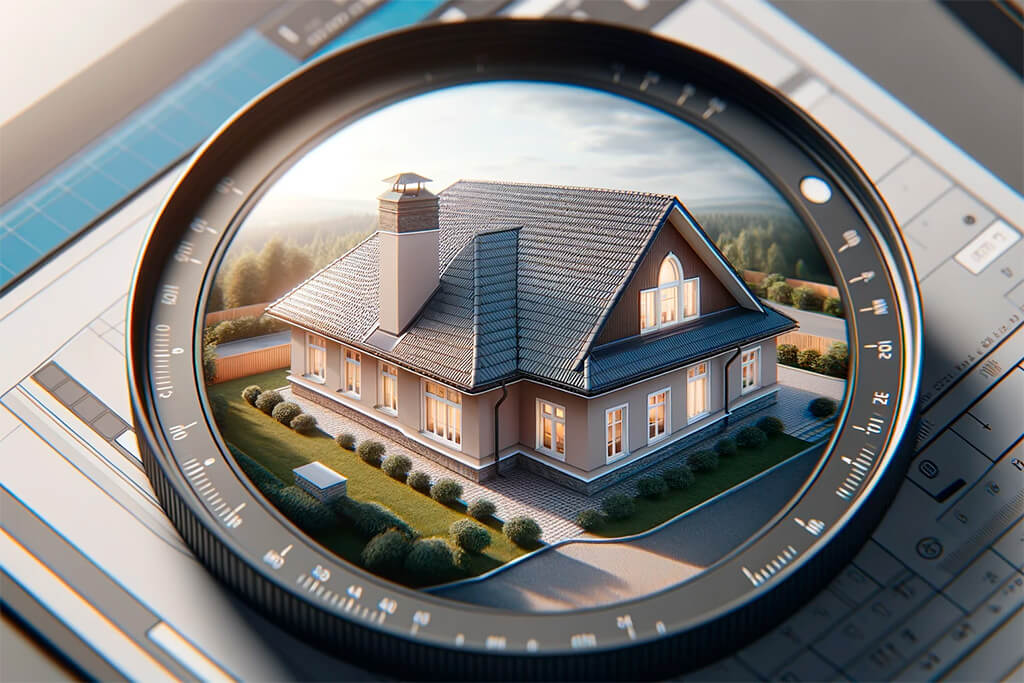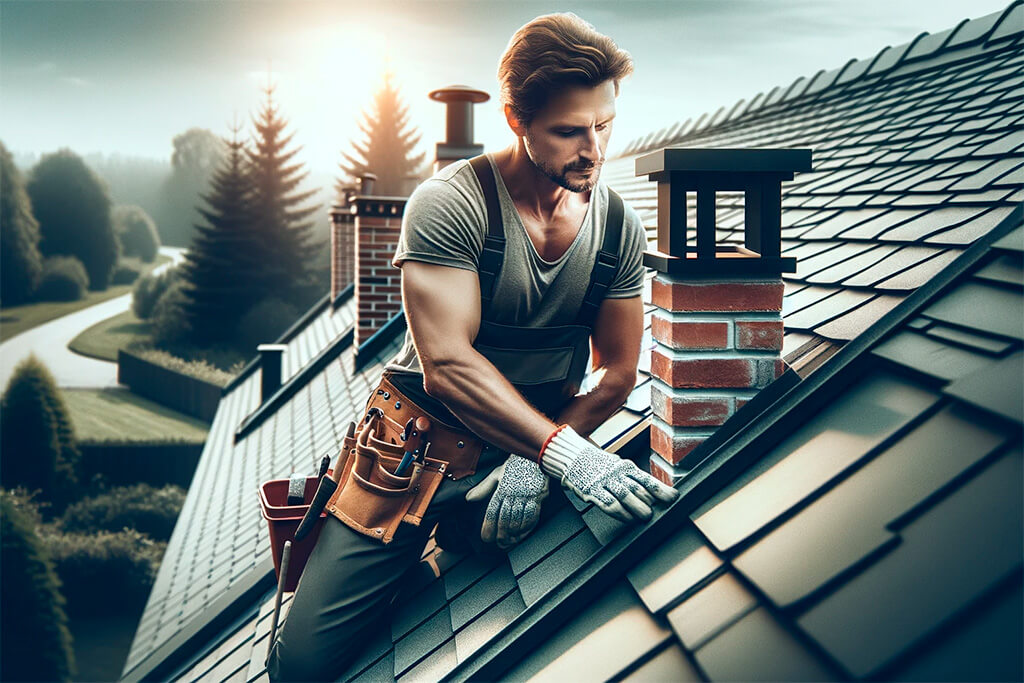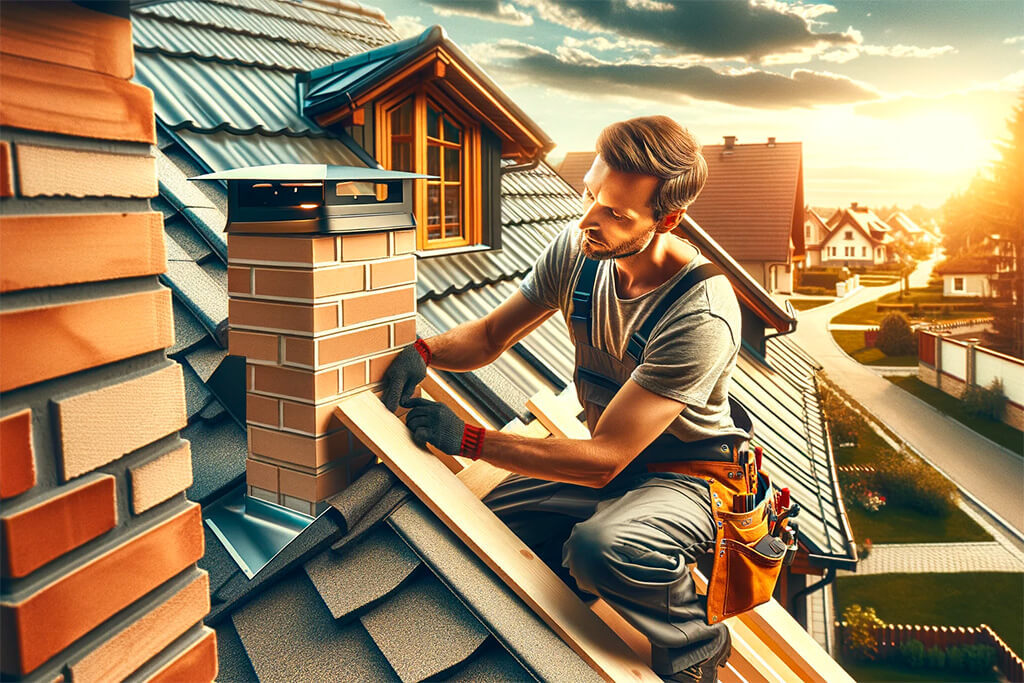In the world of home maintenance, few tasks are as vital yet often overlooked as chimney flashing. This isn’t just about keeping your socks dry, it’s about safeguarding the very integrity of your home. In this guide, I’m going to walk you through the ins and outs of chimney flashing – laying out the what, why, and how in a way that’s both detailed and digestible, no matter your skill level.

Understanding Chimney Flashing
Demystifying Chimney Flashing
Chimney flashing is the unsung hero in the battle against the elements. It’s a set of metal sheets that seal the gap between your chimney and roof, acting as a barrier against water intrusion. Imagine it as a custom-made raincoat for your chimney, tailored to keep moisture out.
Choosing Your Armor
The choice of material for flashing is critical. Each has its strengths and drawbacks. Aluminum, for instance, is lightweight and easy to shape but can succumb to corrosion over time. Copper, albeit expensive, offers longevity and an aesthetically pleasing patina. Galvanized steel, tough and resilient, needs a watchful eye for rust.
The Role of Good Flashing
Effective chimney flashing does more than just prevent roof leaks. It plays a pivotal role in maintaining the structural health of your home, preventing costly and extensive damage caused by water ingress.

Pre-Installation Considerations
Assess Before You Address
Before embarking on installation, it’s crucial to inspect your chimney. Look for structural issues – loose bricks, cracks, or deteriorating mortar. Address these first. Flashing is only effective when mounted on a solid structure.
Tools of the Trade
Equip yourself with:
– Hammer and nails for securing flashing.
– Pry bar for removing old flashing or shingles.
– Tin snips for cutting the metal to size.
– Caulking gun and high-quality roofing sealant for waterproofing the edges.
Safety: Non-Negotiable
Roof work is not without its risks. Ensure you’re using a sturdy ladder, wear a safety harness, and if the roof slope or height feels intimidating, consider hiring a professional. It’s always better to err on the side of caution.
Next, we’ll get into the brass tacks of installation, where precision and patience are key. Follow along as we ensure your chimney is well-armored against whatever the skies throw at it.

Step-by-Step Guide to Installing Chimney Flashing
Installing chimney flashing might seem daunting, but with the right approach, it’s a manageable task. Here’s a methodical, step-by-step guide that will ensure your chimney is properly protected against water damage:
- Measurement and Preparation: Start by accurately measuring your chimney. This ensures you purchase the correct amount of flashing material. Remember, precision in measurement is key to avoiding unnecessary waste and ensuring full coverage.
- Removing Old Flashing: Carefully remove any old flashing and debris. This step is crucial for a clean, stable surface. Be thorough but gentle, you don’t want to damage the existing roofing material.
- Installing Base Flashing: The base flashing is your foundation, so install it with care. It should be snug under the shingles at the bottom of the chimney. Secure it with nails, but remember, excessive force can cause more harm than good.
- Step Flashing Application: Apply the step flashing meticulously, ensuring each piece overlaps the one below it. This overlap is essential for directing water away from the chimney.
- Counterflashing for Added Protection: Counterflashing is your second line of defense. Embed it into the chimney mortar and seal it to create a comprehensive barrier against moisture.
- Applying Sealant: Finish by applying a bead of caulking around the edges. This additional sealant acts as an extra layer of protection, filling any small gaps that might have been missed.

Key Tips:
- Avoid nailing the flashing directly into the chimney. This can lead to structural damage.
- Each layer of flashing should overlap by at least 2 inches for optimal protection.
- Balance is key with sealant application – too little won’t protect properly, but too much can create a mess and potential for trapped moisture.
Common Installation Errors:
- Incorrect overlapping of flashing pieces can lead to water infiltration.
- Inadequate use of sealant can leave your chimney vulnerable to leaks.
Maintaining Your Chimney Flashing
Regular maintenance of your chimney flashing is as important as its initial installation. Here’s how to keep it in top condition:
- Routine Inspections: Biannual inspections are crucial. Look for any signs of damage such as lifting, rusting, or cracking. Early detection of these issues can prevent more significant problems down the line.
- Monitoring for Leaks: Keep an eye out for any water stains or drips inside your home, especially around the chimney area. These can be early indicators of flashing failure.
- Debris Clearance: Regularly clear any debris around your chimney. Accumulated leaves and other materials can trap moisture, leading to corrosion or damage to the flashing.
- Sealant Maintenance: Inspect the sealant regularly and reapply when it shows signs of wear. This maintenance is crucial to sustaining the flashing’s effectiveness.
- Professional Consultations: If you’re uncertain about the condition of your flashing or encounter complex issues, don’t hesitate to consult a professional. An expert eye can often catch things you might miss.
Maintaining your chimney flashing is not just about leak prevention, it’s about maintaining the overall health of your home. Regular care and attention will ensure it continues to perform its vital role effectively.
Troubleshooting Common Issues
In my years of roofing and renovation, I’ve come to recognize the tell-tale signs of chimney flashing troubles and how to address them effectively:
- Leaks: The most obvious sign of trouble is water leakage near the chimney. This often points to compromised flashing. Inspect closely for any cracks, gaps, or misalignments and make repairs as needed.
- Corrosion: Different materials react differently to the elements. For example, copper develops a green patina, which is normal and protective, while steel may show rust, and aluminum can pit. Regular inspections can help catch these issues early, before they necessitate a complete replacement.
- Loose Flashing: Strong winds and weather over time can loosen your flashing. It’s vital to re-secure any loose pieces promptly to prevent water ingress.
When to Call a Professional: If you’re facing extensive damage or if roof work isn’t in your wheelhouse, don’t hesitate to call a professional. They can provide the expertise necessary for a comprehensive fix.
FAQ Section
Aluminum is cost-effective and easy to work with, though not as long-lasting. Copper is more expensive but excels in durability and develops a protective patina. Galvanized Steel is strong but requires vigilance against rust.
The lifespan varies by material. Copper can last 30 years or more, while aluminum may need replacing after 20 years. Regular inspections are crucial for identifying wear and tear.
DIY installation is possible with the right skills and tools. However, if you’re uncomfortable with heights or lack experience, it’s safer and more efficient to hire a professional.
Properly installed flashing should be tightly sealed against both the chimney and roof, with no gaps or loose sections. Water should not pool around the flashing, and there should be no visible signs of damage.
Typical issues include leaks, corrosion, and improper fitting, often resulting from age, environmental factors, or installation errors.
It’s generally advisable to replace the flashing when installing a new roof to ensure a watertight seal and to prevent future issues.
